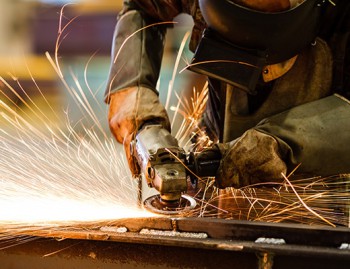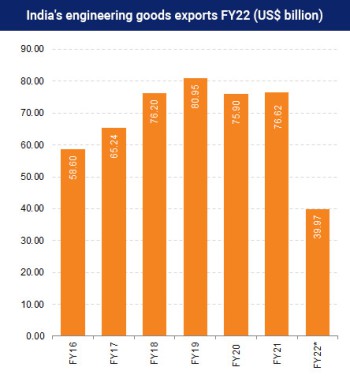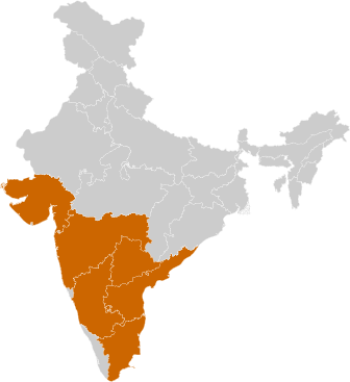INTRODUCTION
The engineering sector is the largest of the industrial sectors in India. It accounts for 27% of the total factories in the industrial sector and represents 63% of the overall foreign collaborations. India’s engineering sector has witnessed a remarkable growth over the last few years driven by increased investment in infrastructure and industrial production. The engineering sector, being closely associated with the manufacturing and infrastructure sectors, is of strategic importance to India’s economy.
India, on its quest to become a global superpower, has made significant stride towards developing its engineering sector. The Government has appointed Engineering Export Promotion Council (EEPC) as the apex body in charge of promotion of engineering goods, products, and services from India. India exports transport equipment, capital goods, other machinery/equipment, and light engineering products such as castings, forgings, and fasteners to various countries of the world. The Indian semiconductor industry offers a high growth potential area because industries which source semiconductors as inputs are witnessing high demand.
India became a permanent member of the Washington Accord (WA) in June 2014. it is now a part of an exclusive group of 17 countries who are permanent signatories of the WA, an elite international agreement on engineering studies and mobility of engineers.

MARKET SIZE

Electrical equipment market is forecasted to grow at 12% CAGR to reach US$ 72 billion by 2025 from US$ 48-50 billion in 2021.
Electrical equipment export market is forecasted to reach US$ 13 billion by 2025, from US$ 8.62 billion in 2021.
The Indian machine tool production and consumption were estimated at Rs. 6,602 crore (US$ 879.38 million) and Rs. 12,036 crore (US$ 1.6 billion) respectively, in FY21.
Market size of textile machinery stood at Rs. 35,000 crores (US$ 5.4 billion) in 2021. Textile industry exports stood at Rs. 3,307 crores in 2020-21, as against Rs 2,556 crores achieved during 2019-20.
The boiler industry’s market size stood at US$ 146 million in 2019 and is expected to grow at a CAGR of 6% to reach US$ 194 million by 2025. Export of boilers stood at US$ 106.53 million between April and November 2020, with around 72 million units exported.
The market size of high voltage switchgear (including panels) and low voltage switchgear (including panels) stood at Rs. 4,793 crore (US$ 679.95 million).
In 2021, between April and December, India exported engineering goods worth US$ 81.8 billion compared with the US$ 52.9 billion recorded in the same period in 2020.
In December 2021, exports of engineering goods from India stood at US$ 9.7 billion, a 37% YoY growth.
India exports engineering goods mostly to US and Europe, which account for over 60% of the total export. Engineering exports were recorded at US$ 75.90 billion in April (FY20) and reached US$ 60.25 billion in January (FY21).
The Index of Industrial Production (IIP) for the electrical equipment manufacturing industry stood at 111.3 in December 2021.
The Index of Industrial Production (IIP) for the electrical equipment industry stood at 92.0 in FY21.
According to the National Association of Software and Service Companies (Nasscom), India’s share in the global engineering and research and development (ER&D) market is likely to expand at a CAGR of 12-13% to reach US$ 63 billion by 2025.
INVESTMENTS
100% FDI is allowed through the automatic route, with major international players looking for growth opportunities to enter the Indian engineering sector. The engineering sector in India attracts immense interest from foreign players as it enjoys a comparative advantage in terms of manufacturing cost, technology, and innovation. The above, coupled with favourable regulatory policies and growth in the manufacturing sector, has allowed several foreign players to invest in India.
FDI inflow for miscellaneous mechanical and engineering industries stood at US$ 3.88 billion between April 2000-December 2021 according to the data released by Department for Promotion of Industry and Internal Trade (DPIIT).
In the recent past, there have been many major investments and developments in the Indian engineering and design sector:
- With 100% FDI allowed through the automatic route, major international players such as Cummins, GE, ABB and Alfa Laval have entered the Indian engineering sector due to growth opportunities.
- In February 2022, Microsoft India and Larsen & Toubro (L&T) signed a Memorandum of Understanding (MoU) to build a regulated sector cloud product. The two businesses will collaborate with a select group of significant customers in regulated industries to design architectures and roadmaps to help them achieve their digital transformation goals and transition traditional datacenters to hybrid cloud architecture.
- In September 2021, Bharat Fritz Werner India, a leading machine tool manufacturer in the subcontinent, announced that it is entering the metal additive manufacturing area.
- In September 2021, Larsen & Toubro (L&T) announced that it will participate in the Expo 2020, Dubai to be held from October 5, 2021, to March 31, 2022, as part of the Indian pavilion. L&T plans to demonstrate its capabilities in hydrocarbon engineering, and businesses such as water-effluent treatment, power transmission and distribution.
- In August 2021, Bharat Heavy Electricals secured its largest-ever order worth Rs. 10,800 crore (US$ 1.45 billion) from the Nuclear Power Corporation of India Limited (NPCIL) for the EPC of a turbine island for 6 units of 700 MW.
- The Auto Component Manufacturers Association (ACMA) expects auto component revenue to increase by 20-30% in the next fiscal year due to demand from OEMs and increase in export. The association expects the Indian auto component export to grow up to US$ 30 billion over the next five years.
- In June 2021, auto component manufacturer Minda Industries announced acquisition of a 51% stake in Harita Fehrer Ltd. for Rs. 115 crore (US$ 15.80 million).
- In May 2021, TVS Motor Company announced that it sold one lakh units of ‘NTORQ 125’ scooter in the international market.
- In April 2021, Tata Power, in collaboration with Hitachi ABB Power Grids and Cargill, commissioned India’s largest natural ester-filled 110/33/22 kV, 125 MVA power transformer in the Mumbai Transmission network at the Bandra-Kurla Complex receiving station.
- In March 2021, Hitachi ABB Power Grids Ltd. bagged order worth Rs. 160 crore (US$ 21.66 million) to supply transformers to the Indian Railways.
- In January 2021, Tesla, the electric car maker, set up a R&D centre in Bengaluru and registered its subsidiary as Tesla India Motors and Energy Private Limited.
GOVERNMENT INITIATIVES
The Indian engineering sector is of strategic importance to the economy owing to its intense integration with other industry segments. The sector has been de-licensed and enjoys 100% FDI. With the aim to boost the manufacturing sector, the government has relaxed the excise duties on factory gate tax, capital goods, consumer durables and vehicles.
- To increase the employability of engineering graduates in the country, Ministry of Human Resource Development is working along with Sector Skill Councils (SSCs) under National Skill Development Corporation (NSDC) to undertake apprenticeship/internship embedded degree programmes with a core focus on the development of knowledge, skills, aptitude and on-job training.
- The AICTE has entered into collaborations with the MSME ministry, NHAI and DM offices in 150 districts to facilitate engineering internships for students.
- In the Union Budget 2022-23, the government has given a massive push to the infrastructure sector by allocating Rs. 199,107 crore (US$ 26.52 billion) to enhance the transport infrastructure.
- The government expanded the ‘National Infrastructure Pipeline (NIP)’ to 9,318 projects worth US$ 2.23 trillion. As of February 2022, there are 2465 projects under development.
- Prime Minister Mr. Narendra Modi, on the country's 75th Independence Day, announced plans to invest Rs. 100 trillion (US$ 1.35 trillion) in infrastructure to stimulate economic development and generate employment.
- In October 2021, the Department of Telecommunications (DoT) approved 31 proposals totaling an investment of US$ 447 million over the next 4.5 years, as part of the PLI scheme for telecom and networking products manufactured in India.
- In October 2021, the Ministry of Textiles allowed pilot projects for application of geo-textiles in infrastructure projects.
- In September 2021, the government announced its PLI scheme of Rs. 10,683 crore (US$ 1.4 billion) for textiles, specifically aimed at boosting production of man-made fibre (MMF) fabric, MMF apparel and technical textiles.
- In September 2021, the Indian government announced a PLI scheme for automobiles and auto components worth Rs. 25,938 crore (US$ 3.49 billion). This scheme is expected to bring investments of Rs. 42,500 (US$ 5.74 billion) by 2026.
- In August 2021, Prime Minister Mr. Narendra Modi launched the Voluntary Vehicle-Fleet Modernisation Program (VVMP), also known as the Vehicle Scrapping Policy. The policy will bring in investments worth Rs. 10,000 crore (US$ 1.35 billion) to set up 450-500 Automated Testing Stations (ATS) and 60-70 Registered Vehicle Scrapping Facilities (RVSF) across the country. A single window clearance portal is being developed where applications for ATS and RVSF will be catered through a single portal within 60 days.
- The government is taking several steps to boost domestic defence manufacturing. In line with this, between FY17 and FY22 (until June 2021), the Indian government has signed 264 contracts for defence equipment procurement, with 159 contracts for armed forces equipment procurement.
- In April 2021, Under the Development cum Production Partner (DcPP) programme, Defence Research and Development Organisation (DRDO) allowed private sector firms to develop and produce missile systems, such as vertical launched surface and air missile system programmes, to promote the domestic defence industry.
- The Indian telecom equipment market is likely to increase owing to the government’s Rs. 12,195 crore (US$ 1.6 billion) PLI scheme approved for telecom gear manufacturing in February 2021.
- The National Infrastructure Pipeline (NIP) was launched in 2020 with estimated infrastructure investment of around Rs 111 lakh crore (US$ 1.48 trillion) between FY 2020-2025, which will drive demand for capital goods.
- In FY21, the Indian government constructed 12,205.25 km of National Highways. The daily average length of the national highways constructed during FY21 was 34 km per day.
- In FY21, Rs. 54.22 crore (US$ 7.30 million) was utilised under the scheme on ‘Enhancement of Competitiveness in the Indian Capital Goods Sector’.
- Government of India allocated over Rs. 80,250 crore (US$ 12.01 billion) for upgradation of 125,000 kms of rural roads under phase-III of the Pradhan Mantri Gram Sadak Yojana.
ROAD AHEAD
Turnover of the capital goods industry was estimated at US$ 92 billion in 2019 and is forecast to reach US$ 115.17 billion by 2025.
India’s engineering R&D market will increase from US$ 36 billion in FY19 to US$ 63 billion by FY25.
India needs Rs. 235 trillion (US$ 3.36 trillion) worth of investment in infrastructure in the next decade (2020-29).
The export of engineering goods is expected to reach US$ 200 billion by 2030.
References: Media reports, Press releases, EEPC India, Press Information Bureau (PIB), Department for Promotion of Industry and Internal Trade (DPIIT), The Confederation of Indian Industry (CII), Indian Electrical & Electronics Manufacturers’ Association (IEEMA)
Note:F- Forecast Disclaimer: This information has been collected through secondary research and IBEF is not responsible for any errors in the same.

Engineering Clusters
- Maharashtra
- Tamil Nadu
- Andhra Pradesh
- Telangana
- Gujarat
- Karnataka

Industry Contacts
- National Automotive Testing and R&D Infrastructure Project (NATRiP)
- The Automotive Research Association of India
- Engineering Export Promotion Council (EEPC)